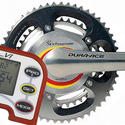Even though the rider accounts for 70% of the aerodynamic drag in cycling, any savings in drag for the bike are important. There is a huge amount of money and time invested in trying out different bike and wheel designs. Wind tunnel testing is an essential part of this quest.
Aerodynamic bike helps lead to Tour de France victory
The importance of aerodynamic bikes was highlighted in the 1989 Tour de France time trial event. Before this time trial event, Greg LeMond was trailing Laurent Fignon by 50 seconds. LeMond used an aerodynamic bike and equipment that gave him an aerodynamic advantage that helped him make up 58 seconds and win the tour by 8 seconds!
To do this, he used:
- aerobars that allowed him to adopt a more streamlined position
- an aerodynamic wheel that causes less drag than that caused by normal spokes moving through the air
- an aerodynamic helmet that has a teardrop shape to fill in the low pressure zone that occurs behind the head – this helmet produces less drag than a shaved head and certainly less drag than a cyclist with loose hair. (If Fignon had cut off his ponytail, it is possible that he would have reduced his drag enough to be 8 seconds faster and win the tour!)
The world 1-hour record
A notable innovator in terms of aerodynamic design is Scottish rider Graeme Obree. His bike design allowed him to ride with his arms and hands tucked in under his chest. In 1993, he set a new world record by cycling 51.596 km in 1 hour. The international cycling union (UCI) later banned this position.
Obree went on to develop a new position known as the ‘Superman’ position, using aerobars but with the arms extended fully out in front. The UCI have also since banned this position. Their strict rules limit advances to cycling aerodynamics to within strict guidelines and measurements.
A movie called The Flying Scotsman gives a good insight into Obree’s innovative approach to reducing aerodynamic drag.
Wind tunnel testing
Wind tunnel testing is an essential tool for the modern bike designer to improve airflow and reduce drag.
These are some of the techniques used to analyse aerodynamic efficiency:
- Smoke trails – small trails of smoke show the layers of air as they flow over the bike to observe the direction of airflow and where these layers become turbulent.
- French chalk – some people mix special powdered chalk with a liquid. This is spread onto the different parts of the bike. The chalk dries in the wind tunnel, leaving visible patterns.
- Tuft wand – a small piece of thread such as cotton or wool is attached to the end of a thin rod. The person testing the bike holds the tuft at different places to see direction of airflow and whether it is a laminar flow or turbulent flow.
In a sport where events are often won by a few hundredths of a second, any competitive advantage is desired.
Human-powered land vehicles
As well as Graeme Obree’s bikes, there are other bicycles that are outside the limitations set down by the UCI. Recumbent bikes fall into this category.
The rider lies back so that their legs are out in front. These vehicles are very close to the ground so the frontal area is very low. This reduces the drag significantly. Some vehicles also have aerodynamic enclosures to reduce drag to a minimum.
Before recumbent bicycles were banned, there were several new records set in cycling competitions.
Today, competitions continue, but these are outside of normal cycling events. Nevada is a popular location for land speed attempts. In 2009, Sam Whittingham set a new record by travelling at 133.284 km/h (82.819 mph).
To show what can be achieved by further reducing drag to an absolute minimum, some riders cycle behind a motorised vehicle. In 1995, Fred Rompelberg cycled behind a pace vehicle to set a record of 268.831 km/h (167.044 mph)!
Both these records have since been broken, see the useful links below for more information, what do you think has changed so that these cyclist can go faster?
Related content
Researchers use wind tunnels to help determine the aerodynamic drag around a cyclist. They then try to come up with innovative ways to help increase speed.
Useful links
Watch the 1989 Tour de France time trial battle between Greg LeMond and Laurent Fignon on YouTube.
Watch this video about Greg LeMond’s handlebars on YouTube.
Read about a group of Dutch students racing attempts in 2013, they were able to clock 133.78kmh (83.13mph) in their recumbent bicycle, beating Sam Whittingham's record.
In 2018 Denise Mueller-Korenek set a new world record for paced bicycle land speed, reaching 184 mph, watch how she did on this YouTube video.





